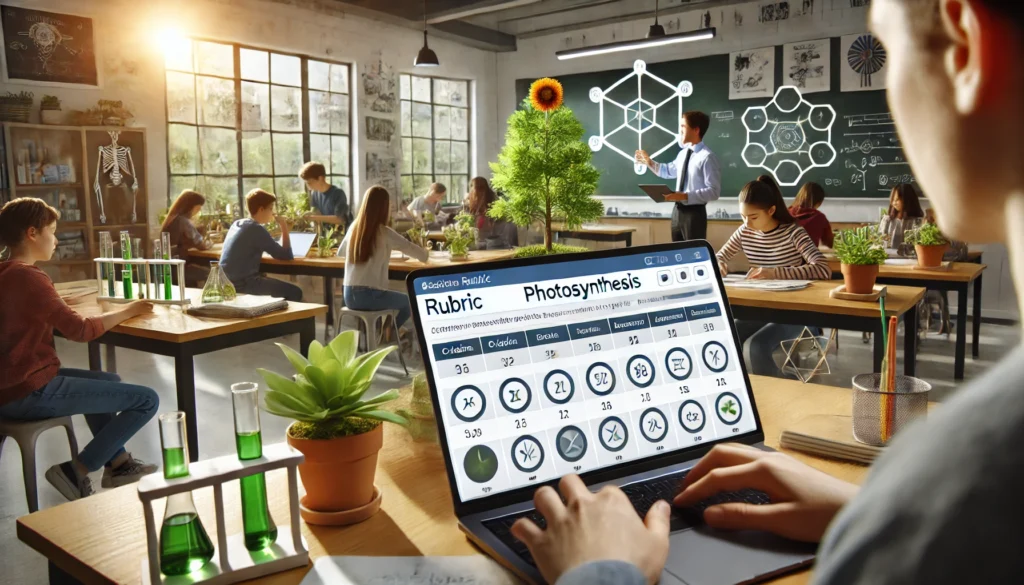The Assessment Challenge
Classroom assessment is one of the cornerstones of effective teaching and learning, serving as a rich source of information regarding student growth and a guide for instructional decisions. Traditional exit tickets or homework have long faced challenges with inconsistency, subjectivity, or misalignment with learning objectives.
Standards-based grading (SBG) offers promising solutions by focusing on assessing students’ proficiency on a set of well-defined objectives and providing opportunities for educators to diagnose challenges students face in their learning journey and offer detailed guidance. SBG presents implementation challenges for many teachers, including cognitive difficulties in differentiating academic performance levels, time-consuming grading and reporting processes, and challenges in communicating the results with students and parents. Creating high-quality rubrics, while essential for fair and informative assessment, remains a complex and time-consuming process for educators.
Introducing Colleague AI’s Rubric Generation
Colleague AI introduces its innovative, unique solution through its Rubric Generation function, which significantly increase the efficiency of how educators approach assessment design. The platform utilizes technological innovations that embed contextual knowledge from educational standards and theoretical frameworks to ensure consistent alignment with learning objectives.
How It Works
The Rubric Generation function offers a streamlined process:
- Input Flexibility: Teachers can provide materials in various formats, including Word documents, PDFs, and even photos of handwriting
- Customization Options: Educators specify grade levels, subject areas, and relevant standards, and other requirements (such as support for students with various learning disabilities)
- Standards Integration: Seamless alignment with frameworks like Common Core State Standards (CCSS) and Next Generation Science Standards (NGSS) and state learning standards
- Teacher Control: All generated rubrics remain fully editable, ensuring educators maintain oversight
A Day in the Life: Ms. Johnson’s Middle School Science Class
Meet Ms. Johnson, a dedicated middle school science teacher preparing for her unit on photosynthesis. Like many educators, she previously invested significant time creating rubrics to ensure fair and thorough assessment of her students’ understanding of this crucial biological process. This year, she leverages Colleague AI’s Rubric Generation function to enhance her assessment planning.
As she begins her preparation, Ms. Johnson follows her structured workflow:
- Building the Standards-Based Rubric
- She inputs the relevant NGSS standards for photosynthesis, focusing on MS-LS1-6 (constructing scientific explanations about the role of photosynthesis in cycling of matter and energy flow).
- If she already has an assessment, she can select the option to generate specific rubrics for the assessment.
- Implementing the Instructional Framework
- Ms. Johnson selects a framework that emphasizes both content mastery and scientific inquiry skills.
- She includes specific criteria for lab work, scientific diagrams, and written explanations about the photosynthesis process.
- Incorporating Accessibility Requirements. For her students with visual disabilities, she specifies the need for:
- Alternative assessment methods for diagram-based questions.
- Audio descriptions of visual concepts.
“What I appreciate most about this system,” Ms. Johnson reflects, “is how it helps me create assessments that maintain high academic standards while ensuring all my students can demonstrate their understanding of photosynthesis effectively.”
Preserving Educator Autonomy While Enhancing Efficiency
The beauty of Colleague AI’s approach lies in its balance between automation and teacher control. Here is how Ms. Johnson maintains her autonomy:
- Customization Control: While the system generates initial rubrics, Ms. Johnson can modify every aspect to match her teaching style and student needs
- Assessment Flexibility: She decides whether to share answer keys with students for formative assessments or keep them private for summative evaluations
- Final Decision-Making: No grades are released to students without her review and approval
- Pedagogical Freedom: The system supports, rather than dictates, her teaching methods
A New Chapter in Assessment
The integration of Colleague AI’s rubric generation function represents more than just technological advancement, because this technology transforms how we approach assessment while maintaining the crucial role of teacher expertise. As Ms. Johnson’s experience shows, when technology supports rather than supplants teacher judgment, the result is more effective, personalized, and growth-oriented education. In addition to generating rubrics, Colleague AI can help Ms. Johnson perform AI-assisted grading and draft student feedback reports. In a future blog, we will share more use cases of AI-assisted grading.
Acknowledgement
This blog is based on a research journal article, titled “Rubric Generation in Colleague AI: Transforming Assessment in Education,” and authored by Zewei (Victor) Tian, Lief Esbenshade, Alex Liu, Shawon Sarkar, Zachary Zhang, Kevin He, Min Sun


